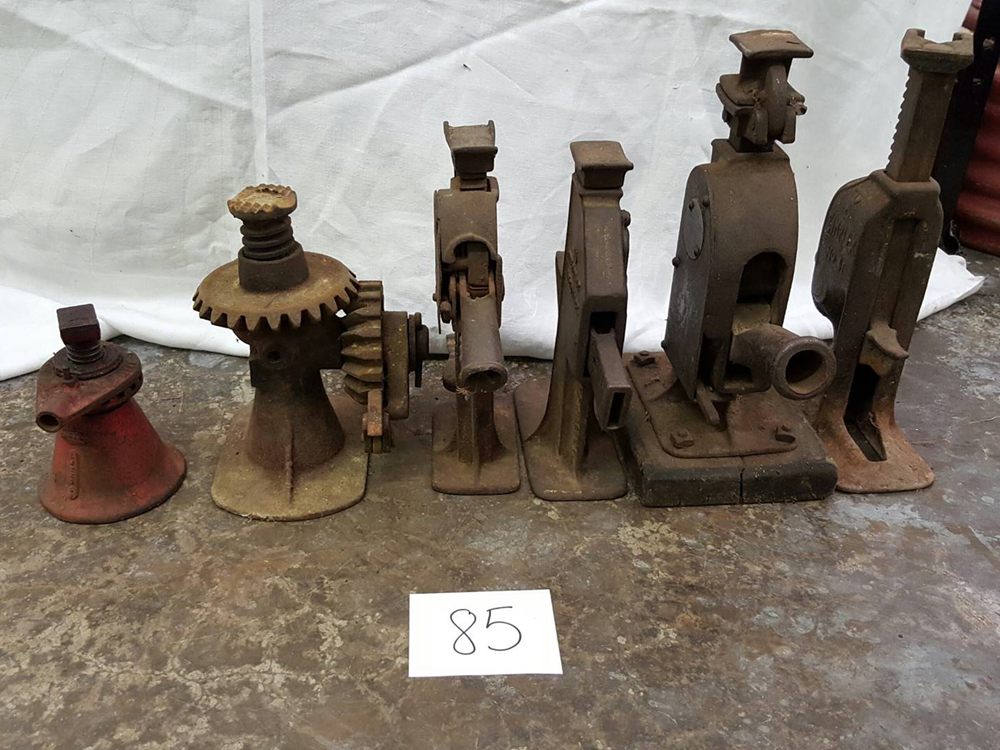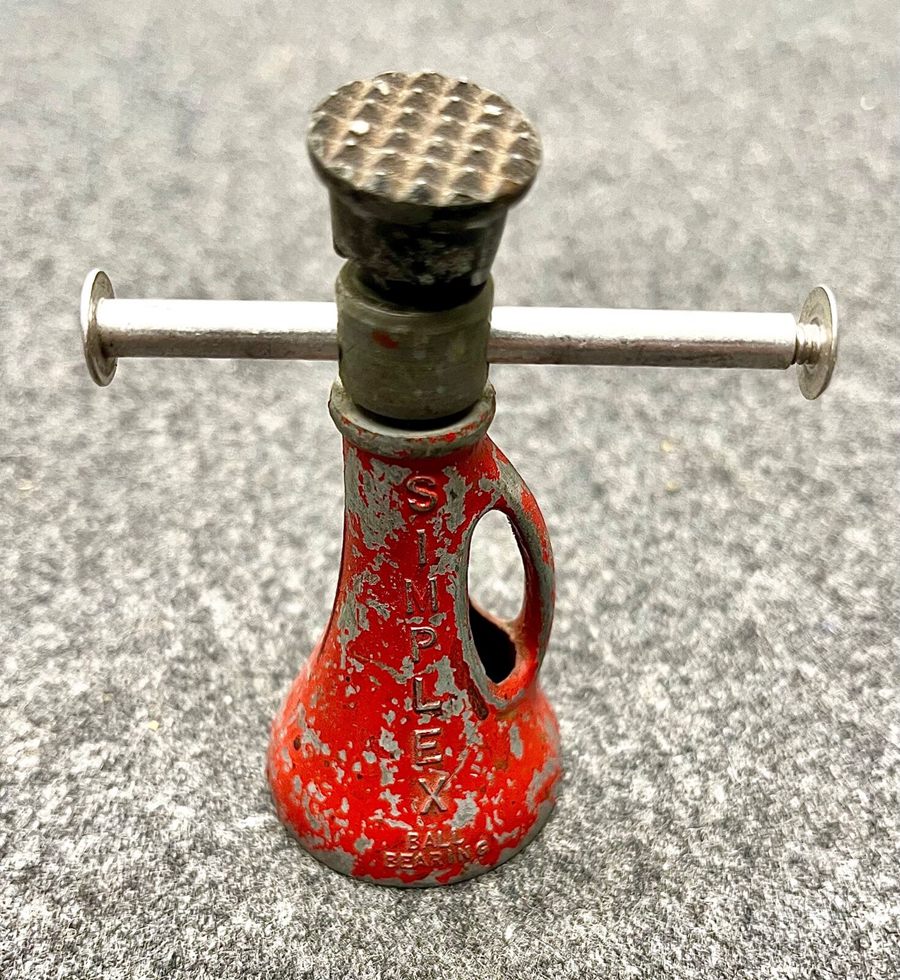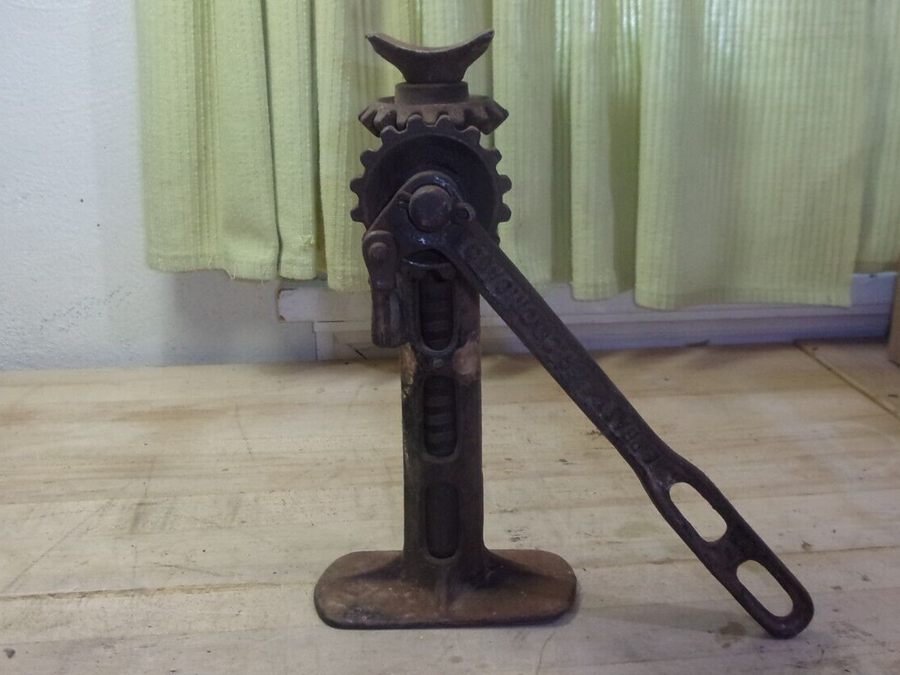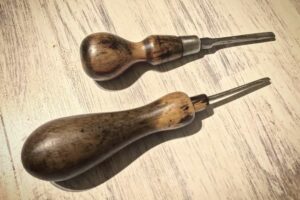Antique car jacks hold a special place in the hearts of collectors, automobile enthusiasts, and history buffs alike. As you embark on your journey to learn about the identification and value of these unique tools, you’ll come to appreciate their historical significance and the stories they tell about transportation and inventions in the past. The very first patent for a car jack was filed in 1838 by British inventor William Joseph Curtis, and since then, different designs and materials have emerged to shape the industry and the way we maintain our vehicles today.
To begin identifying the antique car jack in your possession or one you come across, pay close attention to any trademarks or logos it may have. Many manufacturers, such as Barrett or Hi-Lift, used identification stamps or stickers on their units, including serial numbers as a helpful resource. Additionally, you’ll notice distinct thread types in antique car jacks, such as square, trapezoidal, buttress, and chisel. Flat square or buttress threads are particularly valuable, with price tags falling between $300 and $400, while trapezoidal threads are newer and more affordable, at around $150.
Throughout this guide, you’ll gain in-depth knowledge about antique car jacks, their features, identification methods, and the factors that contribute to their overall value. Armed with this information, you’ll be able to navigate the world of antique car jack collecting with confidence and a keen eye for the unique pieces of history they represent. Remember, patience and practice will only strengthen your ability to identify and assess the value of these fascinating tools from the past.
Table of Contents
The History & Evolution of Antique Car Jack
In the early days of automobiles, around the late 19th and early 20th centuries, you would have noticed that car jacks were quite different compared to modern ones. The first car jacks were simple, often manually-operated devices, mainly used to lift cars for tire changes and routine maintenance.
Many early car jacks were screw-type models, which utilized a simple screw mechanism to raise and lower the vehicle. To use one of these jacks, you would place the device under your car at the designated lift point, then turn the handle to raise or lower the car. These early models were made of cast iron and sturdy materials, designed to last and withstand the weight of the heavier vehicles of that era.
As automobile designs evolved throughout the 20th century, so did car jacks. Some significant changes in car jack designs included:
- Hydraulic jacks: These jacks began to emerge in the early 20th century, offering an improved method for lifting cars. Using hydraulic fluid, these jacks provide a smoother and more efficient way to lift your vehicle for maintenance, requiring less physical effort compared to screw-type jacks.
- Scissor jacks: A new, compact design that became popular in the mid-20th century. Scissor jacks use a simple, foldable design for easy storage and convenience, making them ideal for emergency tire changes. To operate a scissor jack, you would insert the handle into the jack and rotate it, causing the scissor mechanism to extend and lift your car.
- Floor jacks: These jacks, also known as trolley jacks, started gaining popularity later in the 20th century. Floor jacks are designed to be wheeled underneath your car and feature a hydraulic cylinder that raises the car off the ground when the handle is pumped. Floor jacks provide a more extensive range of motion than earlier designs, making them suitable for various vehicle models and types.
As you explore antique car jacks, you’ll come across various models, materials, and designs that reflect the history and progression of these essential automotive tools. Understanding the different types of antique car jacks and how they have evolved over the years can help you identify and value them more accurately.
How to tell if Car Jack is Antique or old
To determine if your car jack is antique or old, there are a few key steps you can follow:
- Look for a date code: Car jacks with date codes are typically post-1967, so finding one without a date code might indicate it’s an antique (older than 1967). Date codes were introduced in 1966 and implemented on car jacks in 1967 to enhance auto safety.
- Examine the trademark or logo: Start by searching for a manufacturing label or logo. Manufacturers like Barrett or Hi-Lift may have identification stamps or stickers on their units. These jacks will have serial numbers, which can be a helpful resource in determining their age.
- Assess the weight and dimensions: Get a small weighing scale and place your jack on it. If it weighs 25-30 lbs and has a 3-5 foot body, it’s likely old and hand joint, potentially costing $400-$500. Lighter jacks may be newer and less valuable.
Once you’ve gathered this information, consult sources like online antique car jack forums or local antique dealers for further assistance in identifying and valuing your car jack. Remember that regularly cleaning and maintaining your antique car jack will help preserve its value.
4 Types of Antique Car Jack and Their Values
Screw Jacks
Screw jacks, also known as mechanical jacks, are one of the earliest types of car jacks. To identify an antique screw jack, look for square, trapezoidal, buttress, or chisel threads. The flat square or buttress threads are considered more valuable, with prices ranging from $300 to $400. Trapezoidal thread screw jacks are newer and less expensive, around $150.
Hydraulic Jacks
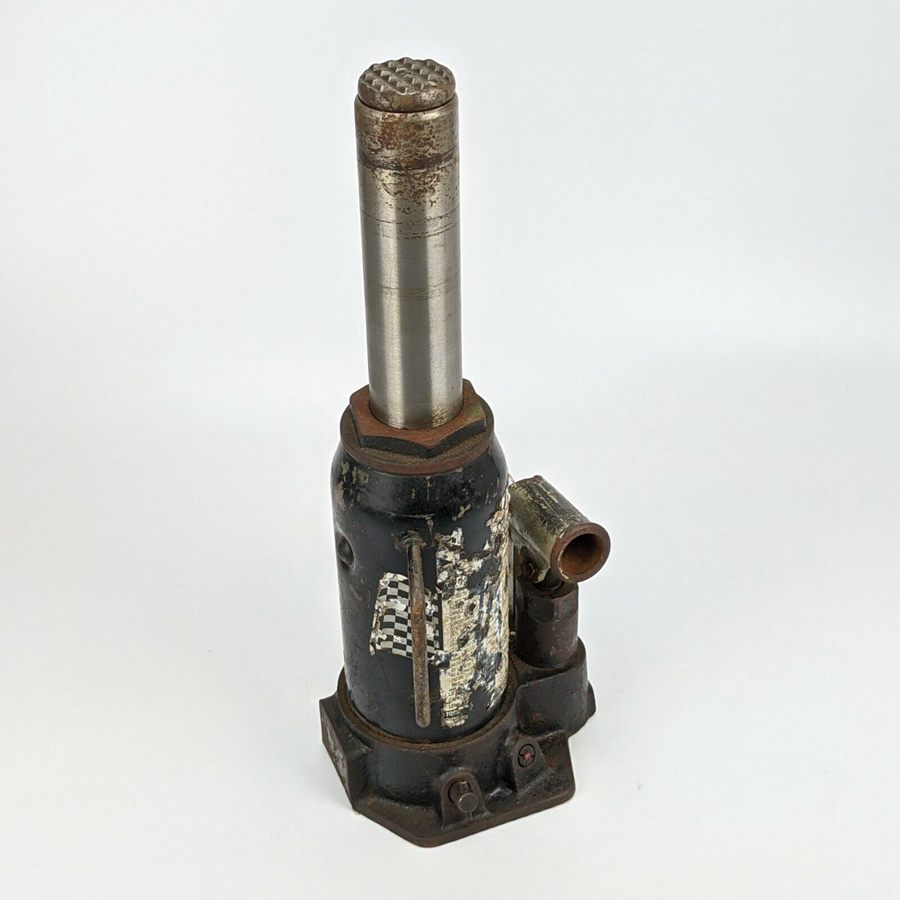
These jacks use liquid pressure to lift vehicles, and antique hydraulic jacks tend to be quite rare. When identifying antique hydraulic jacks, look for logos or brand names that can help you determine its origin and age. The value of antique hydraulic jacks can vary greatly depending on factors like age, rarity, and condition. Some models may fetch upwards of $200, while others may be valued closer to $100.
Bumper Jacks
Bumper jacks are designed to lift vehicles by their bumper and were popular through the mid-20th century. To identify an antique bumper jack, check for a vertical bar with a lifting mechanism attached to a base. These jacks can sometimes be identified by logos or brand names stamped into the metal. The value of antique bumper jacks will depend on factors like age, rarity, and condition. Commonly, these jacks can range in value between $50 and $200.
Ratcheting Jacks
Ratcheting jacks, or scissor jacks, utilize a scissor mechanism for lifting. Antique ratcheting jacks tend to be smaller than modern versions and are often designed for specific vehicles or applications. To identify an antique ratcheting jack, look for a scissor mechanism and any logos or brand names stamped into the metal. Values for these jacks will vary greatly. In general, antique ratcheting jacks can range between $75 and $250, depending on the rarity and condition.
Identifying Antique Car Jacks
When it comes to identifying antique car jacks, there are several factors to consider. By paying attention to details such as popular brands and logos, materials used, year of production, weight, size, and patent numbers, you can determine the authenticity and value of an antique car jack.
Popular Antique Car Jack Brands & Logos
To identify the manufacturer of an antique car jack, look for:
- Logos or names on the jack
- Specific markings, such as found on Barrett or Hi-Lift jacks
- Serial numbers, which can be useful for tracking down information
Some notable antique car jack manufacturers include:
- Barrett
- Hi-Lift
- Duff-Norton
- Buckeye
- Walker
Materials Used
Look for the materials used in the construction of the jack:
- Cast iron or steel for older, more valuable models
- Aluminum or lightweight metals for more recent and less valuable models
Year of Production
Determining the year of production can be challenging, as there may not be clear information stamped or marked on the jack. However, you can try:
- Looking for any dates stamped or written on the jack
- Comparing the jack’s design and features to known models within your timeframe of interest
- Consulting antique car jack resources, forums, or collectors for further guidance
Weight and Size
Compare the weight and size of the jack to known antique models:
- Antique car jacks typically weigh 25-30 lbs
- They often have a 3-5 foot body
- Newer, less valuable jacks are generally lighter and more compact
Patent Numbers
Patent numbers can provide vital clues for identifying an antique car jack:
- Look for patent numbers stamped or engraved on the jack
- Use databases, such as the United States Patent and Trademark Office (USPTO), to search and match the patent information
- Cross-referencing the patent information with known models can help narrow down identification and value
By utilizing the above information and approaches, you can successfully identify and assess the value of antique car jacks for your collection.
10 Factors to Identify & Value Antique Car Jack
1. Antique Car Jack’s Age
When identifying an antique car jack’s age, several factors can help determine its value. One important aspect is the construction material. Wooden lift jacks or wagon jacks are considered exciting antiques. Many early Model T car jacks were made of cast iron, so the material can be a good indicator of whether a jack is an antique or not. If your car jack is heavy and simply mechanized with signs of rust, it may have some value as an antique.
Another factor is the jack’s rarity in the market. If your car jack is extremely rare, especially if it was made by a well-known company between the 18th and 19th century, it can be quite valuable. The current state of the jack will also impact its value: if it’s still in good shape, you can resell it at your local car repair shop for a higher price.
Here’s a table representing a valuation range for antique car jacks based on various factors:
| Antique Car Jack’s Attribute | Average Valuation |
|---|---|
| Wooden Lift Jack | $300 – 350 |
| Cast Iron Jack | $400 – 500 |
| Less Common Jack (Rare) | $450 – 550 |
| Good Shape Jack | $500 – 600 |
Keep in mind that these valuations are subject to fluctuations depending on the specific item and market demand. To be sure of your antique car jack’s age and value, consult with an expert in antique car parts or a specialized appraiser. They can provide you with accurate information and advice on preserving your jack’s value for potential resale.
2. Antique Car Jack Manufacturers
Antique car jacks are sought after by collectors and enthusiasts alike for their historical significance, craftsmanship, and rarity. Identifying antique car jacks can be tricky, as they were often produced by various manufacturers with different markings and styles. In this section, we will discuss some key factors to help you identify and value your antique car jack.
Manufacturer’s Markings
Start by searching for any logos or names on the antique car jack. These markings are crucial as they indicate the manufacturer and, in many cases, the year of production. Some well-known manufacturers include Barrett and Hi-Lift, which have identification stamps or stickers on their units.
Serial Number
Look for serial numbers on the car jack, as these can be an excellent resource for determining its age. These numbers can be found on the manufacturer’s website or by contacting them directly.
Valuation
Now that you know what to look for in terms of identification, let’s discuss the factors that affect the value of antique car jacks. Keep in mind that these average prices may vary depending on the rarity and condition of a specific jack.
| Factor | Average Valuation |
|---|---|
| Cast Iron Base and Hand-Polished Iron or Brass Rod | $400 – $600 |
| Cast Iron Base with Steel Rod | $250 – $400 |
| Steel Base with Steel Rod | $100 – $200 |
Remember that while these average valuations can serve as a helpful guide, the true value of an antique car jack depends on its rarity, condition, and demand among collectors. The rarer and better-preserved a car jack is, the higher its potential value. Additionally, be prepared to do further research and consult with experts to determine the most accurate valuation for your antique car jack.
3. Antique Car Jack Material
Antique car jacks come in various materials, with the most common being iron, brass, and steel. When identifying and valuing an antique car jack, it’s essential to consider the type of metal used in its production. Generally, iron and brass car jacks are more valuable compared to steel ones. In addition to the metal, the production era and design of the car jack can significantly impact its value.
Here are some material-based average valuations to help you get an idea of your antique car jack’s worth:
| Material | Average Valuation |
|---|---|
| Iron | $200 – $300 |
| Brass | $250 – $350 |
| Steel | $150 – $250 |
Another critical factor in determining your car jack’s value is the threading. Antique car jacks have different thread designs, such as square, step-like, or trapezoidal threads. Examining the thread type can help you identify the age and origin of the jack, which will further impact its value.
To decide how much your antique car jack could be worth, you can also look for identifying markings, such as logos or names, on the jack’s surface. These markings can provide you with more information about the jack’s manufacturing company and, in some cases, the production year. Please note that your car jack’s condition, rarity, and demand in the market will also play a role in determining its value.
Remember that the given valuations are average estimates and can vary depending on the specific circumstances surrounding your antique car jack. It is essential to consult a professional appraiser or conduct further research for a more accurate valuation of your jack.
Good luck with identifying and evaluating your antique car jack!
4. Antique Car Jack Weight
The weight of the jack can give you an idea of its age and potential value. Here are some tips on how to determine the weight of an antique car jack:
- Find a reliable scale: Use a digital or mechanical scale to accurately weigh the jack. Make sure it’s calibrated properly and set to zero before weighing.
- Weigh the jack: Put the car jack in a suitable position and gently place it on the scale. Take note of the reading, ensuring it’s accurate and stable.
- Compare to known antique jacks: Compare the weight of your jack to the average weight of known antique car jacks to determine if it fits within the range. Keep in mind that weights may vary depending on the manufacturer and specific model.
To help you estimate the potential value of your antique car jack based on its weight, check out the table below:
| Jack’s Weight | Average Valuation |
|---|---|
| 25 – 30 lbs | $400 – 500 |
| 20 – 25 lbs | $350 – 450 |
| 15 – 20 lbs | $250 – 350 |
| 10 – 15 lbs | $150 – 250 |
| 5 – 10 lbs | $100 – 150 |
Remember, the weight of the jack is just one factor affecting its value. Other factors, such as manufacturer, age, and condition, should also be considered when determining the overall worth.
5. Antique Car Jack Size
When identifying antique car jacks, one key factor to consider is their size. Antique car jacks come in various sizes and shapes, which can impact their value. In this section, we will discuss how the size of an antique car jack can influence its valuation.
Here is a table showing the average valuations of antique car jacks based on their size:
| Size (approximate) | Average Valuation |
|---|---|
| 6 – 7 inches | $400 – $500 |
| 8 – 10 inches | $550 – $650 |
| 11 – 13 inches | $700 – $800 |
| 14 – 16 inches | $850 – $950 |
| 17 – 19 inches | $1,000 – $1,100 |
| 20 inches & above | $1,200 – $1,300 |
Keep in mind that these valuations are just average estimations, and the actual value of an antique car jack will depend on other factors such as its age, condition, and rarity. It is also essential to examine other characteristics like the material, manufacturer, and any unique features to better understand its value.
When exploring your antique car jack, pay close attention to identifying marks or logos. Some manufacturers, like Barrett or Hi-Lift, have identification stamps or stickers on their units. These jacks often have serial numbers, which can be a helpful resource in determining their age and value.
Overall, being mindful of the size, along with other factors mentioned, will help you in accurately identifying and valuing antique car jacks. Remember to consult with experts or specialized guides for a more precise assessment.
6. Rarity
When identifying and valuing antique car jacks, rarity is a significant factor to consider. The rarity of an antique car jack impacts its desirability among collectors, which in turn affects its market value. In this section, we’ll discuss factors that contribute to the rarity of an antique car jack and provide a valuation table based on those factors.
A primary aspect to consider is the production era of the car jack. The older the car jack, the rarer it might be as fewer of them have survived over time. Additionally, jacks with unique designs and features are scarcer, increasing their value. Finally, car jacks from prominent manufacturers, like Barrett or Hi-Lift, can also be more valuable due to their established reputation for quality.
Here is a valuation table presenting the average value of antique car jacks based on different factors:
| Factor | Average Valuation |
|---|---|
| 1700s Cast Iron Car Jack | $500 – 600 |
| 1800s Composite Car Jack | $450 – 500 |
| Unique Design Features | $550 – 700 |
| Manufactured by Prominent Company | $400 – 450 |
Keep in mind that these valuations serve as a general guide and can vary depending on the specific circumstances of an individual car jack. To get an accurate valuation, it’s always best to consult with experts or seek out comparable sales data for similar items.
Taking the rarity into account when assessing the value of your antique car jack will help you better understand its worth and potential demand among collectors. By considering factors such as age, uniqueness, and manufacturer, you can more accurately determine the value of your rare find and make informed decisions when buying or selling antique car jacks.
7. Condition
When identifying and determining the value of an antique car jack, the condition plays a significant role. In this section, we will explore various factors affecting the condition and value of antique car jacks, and how to utilize this information in your valuation process.
Factors Affecting Condition and Value
- Presence of original parts: Ensure that all parts are original and not replaced, as this impacts the value.
- Level of rust and corrosion: Examine the jack for rust or corrosion, which can decrease its worth.
- Functionality: A working antique car jack is typically more valuable than a non-functional one.
Valuation Table
In the table below, you’ll find the average valuation for antique car jacks based on their condition.
| Condition | Average Valuation |
|---|---|
| Excellent (fully-functional, minimal rust or corrosion) | $400 – 600 |
| Good (functional, moderate rust or corrosion) | $300 – 400 |
| Fair (functional, heavy rust or corrosion) | $200 – 300 |
| Poor (non-functional, severe rust or corrosion) | $100 – 200 |
Keep in mind that these average valuations are not absolute, and individual values may vary based on factors such as the specific model, manufacturer, and historical significance. To better understand the value of your antique car jack, consider consulting an expert or conducting further research, such as comparing similar items on auction or collector’s websites.
8. Historical Significance
The history of car jacks dates back centuries before the invention of automobiles. One of the earliest versions of a screw jack was designed by Leonardo Da Vinci as a means of lifting heavy loads. However, the first patent for a car jack was filed in 1838 by William Joseph Curtis, a British inventor.
In the early days, car jacks were shaped like a tripod and made of cast iron or steel. They were designed to support the weight of a vehicle and placed under the vehicle’s axle to lift it for maintenance. Due to their durable construction and unique designs, antique car jacks hold historical significance and are sought after by collectors.
To identify and value antique car jacks, consider the following factors:
| Factors to Consider | Average Valuation |
|---|---|
| Date & Age | Varies by age and rarity |
| Jack Rod Materials | Higher for cast iron or steel |
| Car Jack Shape | Varies by design |
| Manufacturer & Brand | Higher for well-known brands |
| Condition & Working Order | Higher for well-preserved jacks |
| Provenance & Documentation | Adds value for collectors |
Each factor can affect the value of an antique car jack. For instance, the age and rarity of a jack might significantly increase its value, especially if it’s a handmade piece. Well-known brands and manufacturers tend to hold higher values than generic or lesser-known ones. Keep in mind that the condition and working order of the jack also impact its valuation. A well-preserved, functional antique car jack may be worth more than one that is rusty or no longer operational. Finally, provenance and documentation can add value to the car jack by providing historical context and proof of authenticity.
When identifying and valuing antique car jacks, it’s essential to carefully examine and research each factor. This will help you gain a deeper understanding of their historical significance and accurately estimate their worth.
Final Thoughts
In your quest to identify and value antique car jacks, it’s crucial to examine any logos or trademarks. Companies like Barrett or Hi-Lift often have identification stamps or stickers on their units, including serial numbers that can be valuable resources. Keep in mind that these jacks come in four thread types: square, trapezoidal, buttress, and chisel.
- Square or buttress threads are considered more valuable, with prices ranging from $300 to $400.
- Trapezoidal threads are more recent and therefore less expensive, with a value of around $150.
When it comes to cleaning antique car jacks, a simple 1:2 solution of soap and water should suffice. Be careful not to damage any markings or logos during the cleaning process, as these are key for identification and valuation.
As a collector or enthusiast of antique car jacks, remember that certain factors such as rarity, condition, and historical significance play a role in determining the value of each piece. Researching the manufacturer and production timelines will further enhance your understanding of the item’s worth.
By following these guidelines and utilizing the available resources, you’re well on your way to becoming a knowledgeable antique car jack collector. With time and experience, you’ll be able to confidently identify and value these fascinating pieces of automotive history.
FAQ
How can I identify if my car jack is an antique?
To identify if your car jack is an antique, you can:
- Check for a trademark or logo on the jack, as many manufacturers such as Barrett or Hi-Lift used identification stamps or stickers on their units, which can include serial numbers.
- Weigh your jack: if it weighs between 25 – 30 lbs and has a 3-5 foot body, it is likely an antique hand joint jack, potentially costing $400 – $500.
What are some common types of antique car jacks?
Some common types of antique car jacks include:
- Screw jacks: These jacks have a central screw shaft that is turned with a handle to raise or lower a vehicle.
- Hydraulic jacks: Similar to modern car jacks, these use a hydraulic piston mechanism to lift the vehicle.
- Ratchet jacks: Characterized by a ratcheting mechanism, allowing the lifting force applied in the handle direction to be transmitted to the lifting platform.
What factors can affect the value of an antique car jack?
Factors that can affect the value of an antique car jack include:
- Age: Older jacks often have more historical significance and are typically more valuable.
- Rarity: Rare models or limited production jacks can command higher prices.
- Originality: Jacks with original parts or unaltered mechanisms are more valuable than those that have been restored or modified.
- Condition: Jacks in excellent working order and with minimal signs of wear will be worth more than those in poor condition or not functional.
Are there any resources for antique car jack enthusiasts?
Yes, there are several resources available for antique car jack enthusiasts, including forums, clubs, and organizations. A popular forum for car collectors is the Antique Automobile Club of America, which offers informative threads where members can discuss, identify, and share advice on antique auto jacks and other tools.
Remember to always approach enthusiast communities with an open mind and a willingness to learn, as these forums can be invaluable resources for increasing your knowledge and growing your collection.

